[youtube=http://www.youtube.com/watch?v=nQbbx-87P8E&feature=related]
A great suit will feel like a suit of armor – it gives you a whole different level of swagger. Nothing makes me feel more like a confident man than when I’m in a killer suit. If I could, I’d wear a suit all day, everyday, whatever the occasion.
I’ll be sharing my passion for suits through a series of article on suits. This particular article is going to take you through the basics of purchasing a suit. In the next few articles I’ll talk about how to find a suit that fits your body type, talk about how to look for quality, and lots more.
So read on to make sure you know exactly what to look for to ensure that your next suit is one of the best of your life.
Step 1: Know Why You’re Buying A Suit
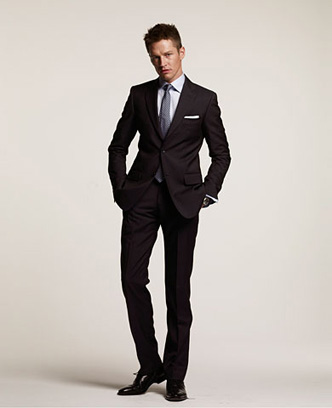
A suit is kind of a big purchase for a man, so this means you need to know as much as you can about choosing the right one before shopping. Otherwise, you may end up with a suit that won’t look or feel right, and end up in your closet rack for decades without use. The first and foremost question you should ask before a purchase is:
What will be the main purpose of the suit?
- If you’re looking for something that you’ll wear to the office often, then keep it dark and classic.
- If you’re looking for a suit to wear to key special occasions, then black or navy is a safe bet.
- If you’re looking for an interview suit, you want to be well dressed but not better dressed than the guy interviewing you, so don’t break the bank on it.
Step 2: Deciding What You Want
Do you know if you want one button, two buttons, or three buttons? Do you want a peak lapel? Do you want side vents? What kind of fabric and color do you want?
Overwhelmed or confused? Don’t worry, I’ll guide you through the options.
a. Choose Your Fabric

If this is your first suit, then stick with a wool suit because it can be worn year-round. Cotton suits should only be worn in the spring, summer, and fall. There are even more choices out there like linen suits which are best for summer days or flannel to keep you warm during harsh winter chills. A wool suit will give you the most for your money, so start there.
As a rule, it’s far better to have two great suits than five mediocre ones. Start with a rich midnight blue, a few shades darker than the average navy. This suit will transition beautifully from day to night, and can be worn with both black and dark-brown shoes.
If you have already own a navy suit, you can go for the next most versatile suit color – charcoal. Then move on to your light colors like light brown or khaki. But sometimes these colors won’t compliment your skin tone, and so in that case go for light gray. This is what you can wear in the summertime to dress down a formal look.
A black suit seems like the logical first choice for a young man but it’s actually the least versatile color. But there are times when only black will do, so you should have one nonetheless.
b. Choose The Number of Buttons
Three-button suits
The three-button suit was very popular in the 90’s because the two-button used to be the conservative main stay, but the tables are turning again. If you’re going to get a three button suit, instead of opting for one of those high-cut versions, look for one with a roll-over lapel—one in which you button the middle button, encouraging the soft lapel to roll over the top button. Taller men may prefer the three-button jacket, which will reach higher on the chest and could be more comfortable or flattering. (more tips like this in the next article)
Two-button suits
The two-button suit is what most guys should wear. Every fashion label imaginable is designing two-button suits, except they’re making them more streamlined and modern, so you’ll see a lot of these around. A man with a shorter torso will appreciate wearing a two-button jacket style. It lengthens your frame, and it has an undeniably classic appeal.
One-button suit
The one-button suit exists, but it’s not for everyone. It’s something you should buy only if you’re in a creative job where the environment is less conservative. If you can pull it off, it’s a sleek look.
c. Choose Your Lapel Type
Avoid narrow and extra wide and keep it somewhere in the middle. Also consider whether you prefer a notched lapel – which is customary – or a more dramatic peaked version.
Classic notched Lapel
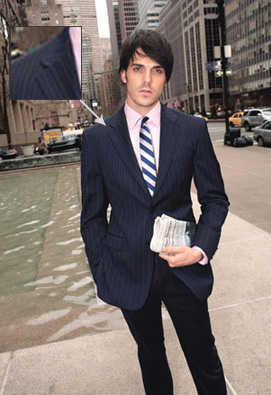
Classic and conservative, a notched lapel always looks sharp.
The Peak Lapel
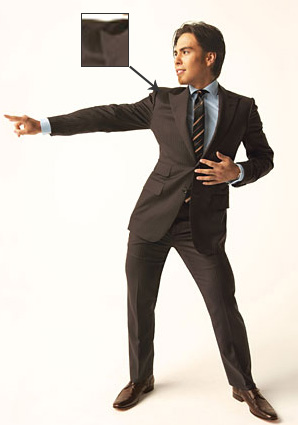
The peak lapel is a bit more daring and stylish.
d. Do You Want Single or Double-Breasted?
The single breasted suit should be your default choice for both work and play. The double-breasted version is a dashing, continental choice that’s chic, but not for men on the shorter or heavier side as it adds fabric to your midsection.
If you’re interested in the double-breasted jacket, make sure you have a single breasted one in your closet first.
e. Choose the Type of Jacket Vent
Double Vents (also known as side vents)
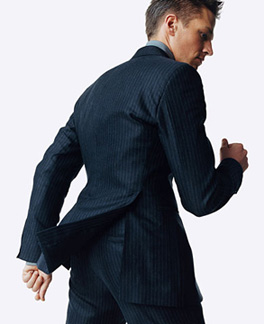
Double vents are more European and a bit more suave. They make it easier for you to reach into your pockets without having to fold your jacket up. But they’re the most expensive to make, so they’re less available than the center vent.
Center Vent
Is modern yet more traditional. You can’t go wrong with a center vent.
No Vent
Ventless jackets are the cleanest and dressiest in appearance, but they aren’t very convenient. The wearer needs to bundle them up to access his pockets.
f. Choose Pleats or No Pleats on Pants
Men’s fashion is getting further and further away from pleats, but they still do come in a more subtle fashion than it used to. It can be flattering to heavier men who need some extra stretch but it’s always flattering to go for flat-front if you can. Personally, I hate pleats and would love if I never saw them on a pair of pants again, but some men do prefer them. So to each his own.
g. Cuffs or No Cuffs?
Cuffs add weight to the bottom of your pants, helping it to hang properly. They’re better for taller guys, but not for shorter guys because it shortens the silhouette of the legs.
Step 3: Know Your Exact Measurements
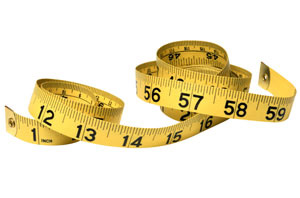
This seems obvious, but make sure you know your exact size, not just the general category of measurements in which you think you fall under. As a matter of fact, you should recheck your size each year. Even if you’ve bought a suit before, don’t keep asking for the same size out of habit. As you gain or lose weight or grow older and gravity takes its toll, your suit size will change.
A suit jacket size is determined by measuring the thickest part of your chest in inches.
1. Begin by measuring just under your armpits and across the chest and over the shoulder blades. Just relax and don’t flex. Make sure you keep the tape measure parallel to the floor when you do this. This will help assure you’re measuring the thickest part of the chest area.
2. You should take an overarm measurement where you place the tape measure over the outside of your arms at your sides and across the thickest part of your chest. Once you have this measurement subtract 7 inches to receive a corresponding chest measurement. Then compare this measurement with the chest measurement and take the larger of the two.
3. Trouser sizes are determined by measuring the waist at the belt line. In most cases, the belt line will be found just on top of your hip bones.
Now that you have all your measurements, on to next step.
Step 4: Purchasing The Suit
If you’re not used to buying suits, a good place to start looking is a department store, for example Barney’s, Bloomingdales or Saks has a vast selection. Step into the store and take a look at the different styles and types of suits they have. See what grabs your attention. Look at prices. Ask for a salesman when you’re good and ready.
Once you see something you like, grab it to take to the fitting room.
Checking The Fit
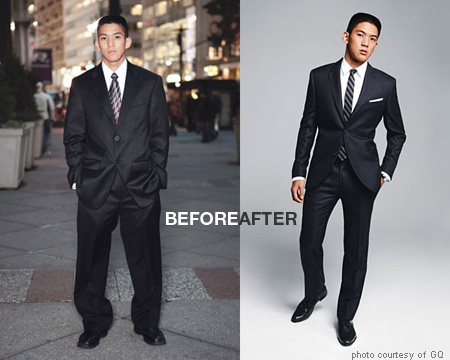
- The shoulders of a jacket are crucial to a good fit. Check this area first to determine if the proper suit size has been chosen. (If you stand sideways against a wall and the shoulder pad touches the wall before your arm does, the suit is too big)
- Very few men can buy a suit without having the collar raised, lowered, or shortened. Look in a three-way mirror. The jacket collar should hug the back of neck with a half inch of shirt collar showing above it. If the shirt is hidden or there is a buckle of excess jacket fabric, try a different jacket (a tailor can also fix this)
- The jacket should not be too long, for example not halfway down your thigh
- For the right length: your jacket should be long enough to cover your buttocks. If you have very long legs, however, you may want to wear your jacket slightly longer than your buttocks to make your legs appear shorter and more balanced. If your legs are very short, you’ll want to wear your jacket just above the bottom of your buttocks in order to give the illusion of longer legs.
- The sleeves should end at the hinge of your wrist, but leave some room to allow a quarter inch of shirt cuff to show.
- You should be able to easily button the jacket without it straining, but there shouldn’t be too much space between the button and your chest — no more than a fist’s worth.
- Turn sides and look at the way the pants hang. Legs should fall straight and center evenly over each foot.
- Pants should sit more at the hip almost like a pair of jeans, not at the navel
- You shouldn’t have to wear a belt (you don’t really need one), and you shouldn’t need suspenders to keep your pants up, it should sit naturally on your waist and stay there
- If your waist in nine inches smaller than your jacket size, you’ll need to have your suits custom-made or get a semi-custom suit. You cannot successfully alter pants with that much drop from shoulder to waist with just a nip and tuck.
*Beware of the sales guy who may talk you into buying a suit a size too big because he will say, “Well you want to be comfortable…” or “this suit will last you for the rest of your life, you’ll grow into it!” Uhhh… NO. If you can, take someone with you that you can trust (who’s blunt and honest) to tell you if something looks horrible.
Step 5: Take It To The Tailor
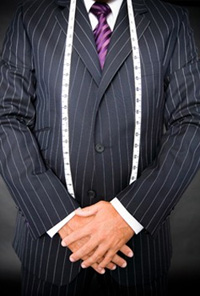
Your tailor will become your best friend. A good tailor can make small tweaks that will be the difference from you exuding style confidence and your outfit being lackluster.
After choosing a suit that’s an exceptional fit, you may want to take it to a tailor for some final touches. You will always have more versatility with a suit that fits you well (a bit on the slim side) because it gives you the option to dress the jacket down with a pair of jeans.
If your pants are an inch or too wide or too tight, a tailor can usually fix them, but don’t buy ones that are more than an inch too big or small (it will look bad even after alterations).
A tailor usually will need to alter the length of the sleeves. Insist that you’d like a quarter inch of shirt cuff to show. The sides of a jacket often need tapering so they contour to your torso. And check out the collar: Many times there is a roll in the back of the suit jacket, up near your neck. A good tailor can correct this.
They can also take your pants in at the thigh, or shorten the length.
After you have had it altered, don’t forget to try it on again before leaving.
Your suit should be well fitted, but not like a straight jacket. Pretend like you’re hailing a cab and see if it’s comfortable to lift your arm. The last thing you want is your suit to burst at the seams while you’re hailing a cab for you and your date.


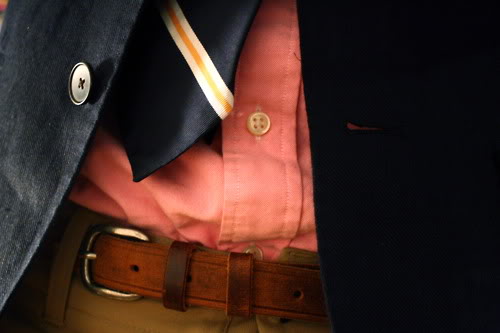
Hey,
Great article. I am going tomorrow to purchase a suit for my interview into Optometry Med School in NYC. Perfect timing for this post! Keep up the good work guys.
For a guy who’s more built than the models shown,what lapel style and how many buttons, would you recommend? I’m not a bodybuilder, but i would also like the suit to complement my physique? For e.g I would love to be in the suit (the well-fitting one) like the asian model shown above, however how do i still pull off that classic well fitted look, without compromising on comfort???????
this is probably the best article on suits i’ve come across. great great job man. i stumbled it, hopefully it helps spread this to others and turns them on to the awesomeness of a suit. 🙂
I was worried after watching your intro video that this post would be singing the praises of the black suit.
When buying a two button, the current trend for budget or low range suits (at least here in Ausralia) is for the high button stance suit. That is, the top button is well above your natural waist (which should be about 2cm above your navel, or there abouts). This can make the suit look like a three button suit that’s missing one of it’s fasteners. Instead, try to find a more stylish lower button stance suit, where the top button sits at your natural waist. It looks far better and you avoid the problems of looking shorter due to all the extra suit fabric around your torso.
Just as a note on the single button suit: It’s casual. This should not be worn for the same reason a black suit should generally be avoided: It is the staple of dinner jacket (or tuxedo), and as such should be reserved for semi-formal or dress casual occasions. A single button mid tone suit can be a brilliant summer time casual statement, but would look totally out of place in any conservative workplace.
Peak lapels make a more dressy, less conservative suit. Keep that in mind when selecting. There is also a lapel style missing from the above post: The shawl lapel. This is a very casual statement though, and is usually reserved for a more casual semi-formal dinner jacket – especially bone coloured summer time dinner jackets.
A note on the double breasted jacket: Never wear it undone. And unlike single breasted, where you must always leave the bottom button unfastened, you may do up all the buttons on a double breasted suit.
A note on the no vent suit: This is also a feature of the dinner jacket. It can make it hard to sit down, and difficult to look relaxed but makes for a striking shillohette. I would suggest reserving no vents for your dinner jacket (or tuxedo).
The part about fit is spot on. Many people buying their first suit (me included) buy their suit as if it is a casual item of clothing. Often this means it fits very poorly.
Just one note on suspenders. They are very comfortable and help keep your shirt tucked in, but generally you should avoid showing them off. This is when a wasitcoat comes in handy, as it covers your suspenders so you can take your jacket off. You should always wear suspenders with a dinner jacket, and should never let your suspenders be seen. However, suspenders work best on suspender pants, which actually come up at the back and have buttons on them to connect the suspenders to. You probably wont find these in any department store.
Woh, that turned into a long comment! Sorry about that.
Good writeup. I’m glad some people are fighting to stop the elegance of the suit from vanishing into the night.
I was worried after watching your intro video that this post would be singing the praises of the black suit, but it turned out to be a good article!
A few notes though. Firstly, there is one lapel style missing, the shawl lapel. This is quite dress casual though and is usually only found on casual dinner jackets (tuxedos), especially the bone white summer dinner jacket.
As for double breasted jackets, these should always be worn done up, and all buttons should be fastened, unlike single breasted.
The part about fit is spot on! Many people buy their first suit loose, treating it like an item of casual clothing. It is not, of course, and it just looks bad.
I was worried after watching your intro video that this post would be singing the praises of the black suit, but it turned out to be a good article!
The part about fit is spot on! Many people buy their first suit loose, treating it like an item of casual clothing. It is not, of course, and it just looks bad.
I was worried after watching your intro video that this post would be singing the praises of the black suit, but it turned out to be a good article! The part about fit is spot on! Many people buy their first suit loose, treating it like an item of casual clothing. It is not, of course, and it just looks bad.
Let me just say that I am excited about this series because I am going to into a hotel management environment and need to look my best. I have a black suit but it’s been around for years.
It’s time I step my game up and take more risks.
Good post and I look forward to checking out the ones that follow.
excellent entry ~ i needed this
hands-down best suit article i’ve read in awhile – i really need a peak lapel suit…so hot
i’m a small guy ( 5’3, 120lbs) i have the damnedest time finding clothes that look and fit right. suits are even worse. a while ago, i discovered a company out of Los Angeles called Thick As Thieves. They are a tailor made, fit to you type of shop, that primarily operates through email and their website. i needed a suit for my buddies wedding and was a bit skeptical. i took my own measurements like suggested and emailed them for further instructions. Jason got back to me and had me take a few more, and re-take some others just to be safe. i figured ‘what the hell…its five hundred dollars. if this goes south, i learned a lesson and could by a suit at one of the Mens suit shops.” ( even though the smallest size, 34short, still didnt fit just right).
2 weeks passed and a package arrives for me. Jacket and pants nicely folded. when i put everything on, it fit like a glove. It was pretty much perfect. the picture of the asian guy up top there, with the perfect fitting suit? that pretty much could’ve been me; i looked pretty freakin slick.. and looked a thousand times better than all the suckers in their flabby, not fitting suits.
Hey this is a fantastic article. One of the best so far. I can only add that if you plan on wearing your new suit as what I like to do is called suit separates. That is to pick up an extra jacket one size larger. This will help if your are wearing fall sweaters, jerseys, thick shirts etc. The extra room by going a one size larger will make the jacket look clean and elegant when wearing layers!!
Excellent. This foundational and totally essential for the suit wearer.
I was thinking about buying a bunch of books on suits – this is a great start. Totally love the part about the lapels. Thanks Jae – I love this site!
Always had issues buying suits that look or felt right. They always seemed to be too big or baggy. I came across recently a largely web based tailor although they do have two premises in London called “cad & The Dandy”… Ordered a couple of suits and they are without doubt the best looking and fitting suits I own. Always get compliements about them and will always buy from these tailors in the future… just shows you how important fit is.
i just wanted to say that I love this site
Over the years at Nelson Wade, we have seen a variety of styles and colors that come an go for a business suit…but the Classic Black Suit with notch lapel and double side vents and plain front trousers with cuffs is always a classic look!
If you want to personalize it…take your black suit to your local tailor and have him or her change the interior lining with a vibrant colorful pattern or maybe a solid red silk lining. Either way it will make you suit a signature suit!
great article, thanx.
Fantastic article. Very helpful. Thanks
Best article I’ve read about suits (and I’m not exaggerating), especially for beginners
Please continue writing articles!
Awesome
Needless to say this is indeed the best suit article i’ve read. informative and practical. Good work man, u just got me hooked
Great post and good advice for people that need to buy their first suit. These pictures of Before/After really make clear the importance of a proper fit!
My spouse and I absolutely love your blog and find a lot of your post’s to be exactly what I’m looking for. Do you offer guest writers to write content to suit your needs? I wouldn’t mind producing a post or elaborating on a lot of the subjects you write about here. Again, awesome website!
Well, this was 2008 and I hope you’ve thought twice by now.
No belt or braces? If you live in dreamland maybe, at least side tab adjusters would be necessary then. The abdomen goes in and out too. Try getting ready to out for a dinner meeting, to after the dinner meeting. You’ll wish you’d thought about adjustment.
No pleats but turn-ups (cuffs)? Okay.
Trousers at the hip is not a good look for a suit. Trousers are not jeans and for all the seeming concern with making legs look longer and creating balance, looking like you’re wearing a 12 year old’s trousers won’t achieve that.
Hi there! Someone in my Facebook group shared this
site with us so I came to look it over. I’m definitely loving the information. I’m book-marking
and will be tweeting this to my followers! Terrific blog and brilliant style and
design.
Great article! Can’t agree more about how a suit makes you feel. A great suit can make all the difference. Also I totally agree about going to a tailor for a bit of fine tuning. So true about the salesman and “you want to be comfotable”
Nice article you shared.. Fabulous beautiful collections..! Thank you.
Mens Made to Measurement